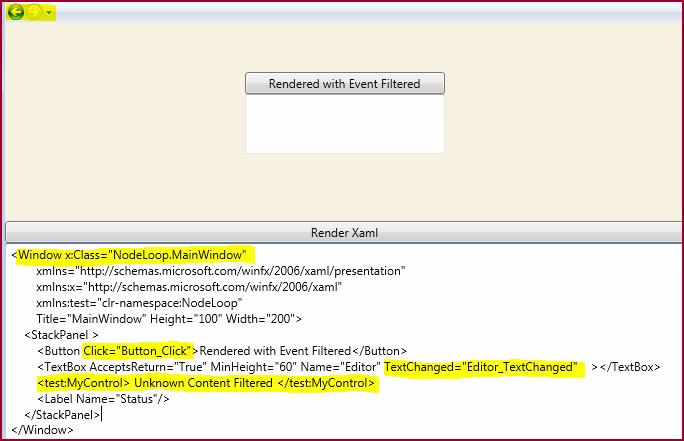XAML 2009 Features: Node Loop flexibility
[This is part of a series on New WPF\XAML Features]
So by now most of you must have noticed the System.Xaml dll as part of your .NET 4 WPF projects. It’s a well componentized XAML stack that provides a lot of flexibility working with XAML. So at the core we a System.Xaml.XamlReader and XamlWriter which provide the base implementation and definition for a reader and writer. XamlXmlReader is a reader that reads in XAML and produces a XAML node stream. This stream is then consumed by a XamlXmlWriter XamlObjectWriter to produce the object graph. Similarly for the Save path, you have the XamlObjectReader and XamlXmlWriter.
So the Load Path looks like
XAML à XXR à Node Stream à XOW à Object Graph
The Save path would look like
Object Graph à XOR à Node Stream à XXW à XAML
Prior to .NET 4, you didn’t have access to the internals; the access points were XamlReader.Load and XamlWriter.Save in PresentationFramework. In .NET 4, we provide access to the node stream and you could manipulate this node loop. There are 7 XamlNodeType’s that you need to look out for in this node loop.
An example of a node loop could be filtering out events and unknown elements. Wouldn’t that make a nice feature in XamlPadX J..
The code below shows how we could replace the Window in the Xaml passed with a Page.
XmlReader xmlReader = XmlReader.Create(input);
XamlXmlReader reader = new XamlXmlReader(xmlReader, System.Windows.Markup.XamlReader.GetWpfSchemaContext());
XamlObjectWriter writer = new XamlObjectWriter(reader.SchemaContext);
while (reader.Read())
{
switch (reader.NodeType)
{
case XamlNodeType.StartObject:
if (!reader.Type.Name.Equals("Window"))
writer.WriteNode(reader);
else
writer.WriteStartObject(new XamlType(typeof(Page), reader.SchemaContext));
break;
case XamlNodeType.EndObject:
case XamlNodeType.StartMember:
case XamlNodeType.EndMember:
case XamlNodeType.Value:
case XamlNodeType.GetObject:
case XamlNodeType.NamespaceDeclaration:
writer.WriteNode(reader);
break;
}
}
Attached is a project that shows how events\unknown elements could be filtered.







